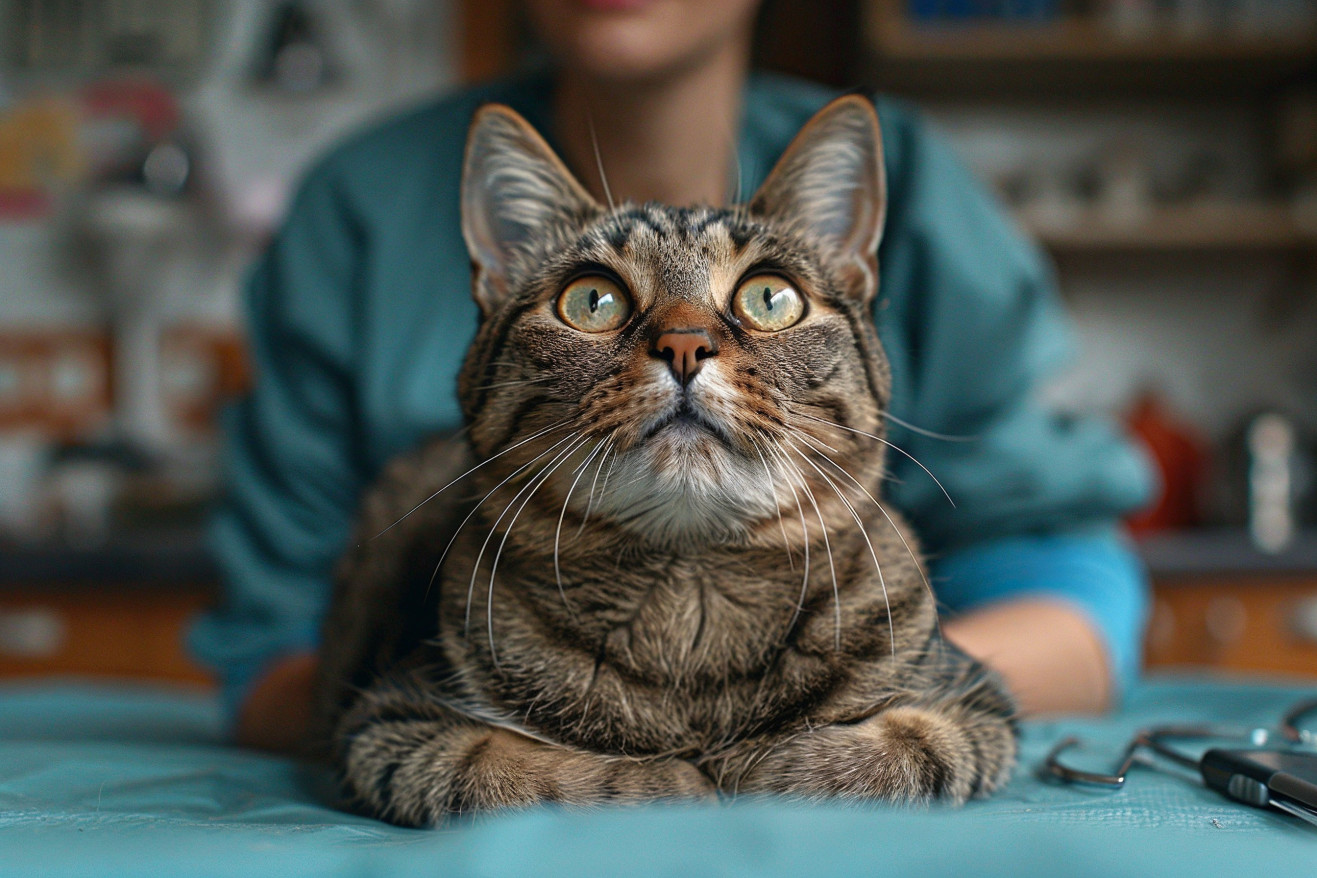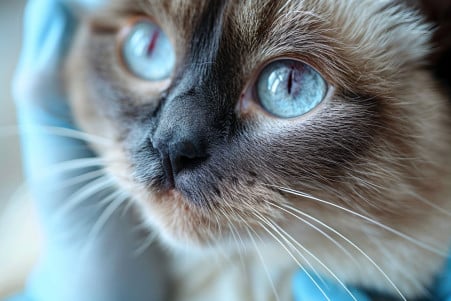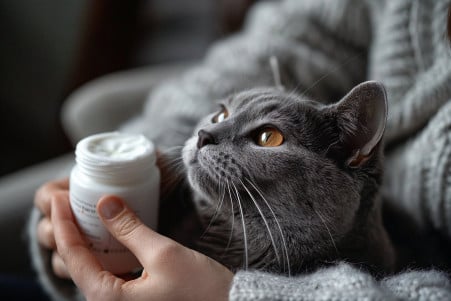Swollen Cat Bottom Lip: Causes, Diagnosis, and Treatment
18 March 2024 • Updated 17 March 2024

If you’ve noticed that your cat’s bottom lip is swollen, you may be understandably concerned. After all, there are a number of potential causes for a swollen bottom lip in cats, including dental issues, allergies, infections, and eosinophilic granuloma complex.
However, regardless of the cause, it’s important to take your cat to the vet to get a proper diagnosis and treatment, which may include antibiotics, anti-inflammatory drugs, or dental work to get to the bottom of the issue and reduce the swelling.
This article will take a deep dive into a range of veterinary research and clinical studies to provide a comprehensive overview of the many reasons why your cat’s bottom lip may be swollen. From in-depth looks at feline dental health to clinical analyses of allergic reactions and skin conditions like eosinophilic granuloma complex, we’ll cover the causes, symptoms, diagnosis, and treatments for each.
Not only will this satisfy your curiosity, but it will also give you the information you need to make sure your cat gets the best care possible.
What causes a swollen bottom lip in cats?
Dental Disease in Cats: Another Cause of Swollen Lips
Many cats suffer from dental disease, and according to PetMD, between 50–90% of cats over the age of four have some form of dental disease. If left untreated, dental disease can lead to swollen lower lips.
Gingivitis, periodontitis, and tooth resorption are the most common dental diseases. According to International Cat Care, these diseases are often caused by plaque and tartar, which can lead to bad breath and tartar on the teeth, and in some cases, swollen lips when the area becomes infected.
Symptoms of dental disease can range from drooling, blood-tinged saliva, to more subtle signs like changes in eating habits, bad breath, and even weight loss. According to the Merck Veterinary Manual, regular dental care, including regular dental exams and cleanings, is important to prevent dental disease and swollen lips.
This is important for catching and treating dental disease early, so your cat can have a happy, healthy mouth that’s free from the pain and discomfort of dental disease.
What Is Eosinophilic Granuloma Complex in Cats?
The term Eosinophilic Granuloma Complex (EGC) refers to a group of skin lesions in cats that, according to the Merck Veterinary Manual, are often the result of an allergic hypersensitivity reaction. One of the most common lesions associated with EGC is the eosinophilic ulcer, which is often found on the upper lip and is sometimes called a “rodent ulcer.”
While these ulcers are usually not painful, they can cause significant swelling in the lip. Other symptoms can include red, raised lesions that are very itchy, leading to the cat scratching and making the problem worse.
EGC is diagnosed by taking a thorough medical history and conducting a physical exam, and sometimes a skin biopsy to confirm the presence of eosinophilic granulomas. Diagnosis can also include blood work and tests for external parasites, such as fleas, which are a common cause, according to a study in PMC.
Treatment usually involves managing the underlying allergies with steroids or cyclosporine and antibiotics if there is a bacterial infection. The Cornell University College of Veterinary Medicine notes that controlling fleas and managing diet are important in preventing EGC flare-ups. For cat parents, knowing about EGC is important because it shows how allergic reactions can impact a cat’s skin directly, leading to issues like lip swelling.
Allergic Reactions in Cats
Allergies in cats can result in a number of different symptoms, one of the most noticeable being swelling of the lips.
According to WebMD, cats can be allergic to a number of things in their environment, including things they eat, inhale, or come into contact with.
The Merck Veterinary Manual states that feline atopic dermatitis, which is caused by allergies, can result in intense itching and skin inflammation, which can be especially bad on the face and result in swelling of the lips.
Allergies can be diagnosed through a number of methods, including blood or skin tests. According to WebMD, blood tests are done in a lab and measure the number of antibodies in the blood, while skin tests involve injecting small amounts of allergens under the skin to see if a reaction occurs. These tests are important for determining the best course of treatment.
Treatment often involves avoiding the allergen, if possible, and the use of medication prescribed by a vet. PetMD recommends that environmental allergies are managed by controlling the environment, including using dust-free litter and regular grooming. When used together, these treatments can help prevent allergic reactions, including lip swelling, and ensure that your cat is happy and healthy.
Seek Immediate Veterinary Care if Your Cat Has a Swollen Lip
If you notice that your cat has a swollen lip, it is important to see a vet. Failing to address symptoms like a swollen lip can make the problem worse, according to Catster. Seeking immediate veterinary care is important because a number of issues, from dental problems to allergies to even autoimmune diseases like eosinophilic granuloma complex, can cause the same symptoms.
When you go to the vet, the vet may do a complete physical exam, dental x-rays, and allergy tests to determine the cause of the swelling. As Dr. Jacobs of the Veterinary Emergency Group and Dr. Arnold Plotnick both note, it is important to get an accurate diagnosis as soon as possible.
Before your appointment, make a note of any changes in your cat’s behavior, diet, or environment. As Rover’s article recommends, keep a log of when you first noticed the swelling and any changes or additional symptoms. This information can help your vet diagnose the issue and come up with a treatment plan.
By addressing the problem as soon as possible, you can help ensure that your cat has the best chance of a full recovery and relief from any discomfort, and you can rest easy knowing that your cat isn’t dealing with an undiagnosed health issue.
Final Thoughts on Cat Swollen Lip
As we’ve worked through the ins and outs of cat swollen bottom lip, we’ve learned about the most common reasons for this worrisome symptom. Dental problems, allergies, and eosinophilic granuloma complex (EGC) are the most common causes, and each comes with its own treatment options and ways to prevent it.
It’s also important to note that early intervention from a vet is key and will help ensure that your cat is diagnosed and treated properly, which will help them stay healthy and happy.
Cat parents should make sure that they are keeping a close eye on their cat’s health and well-being and that they are looking out for any changes in their behavior or physical health that could be a sign of an underlying problem. Regular vet visits are also important for maintaining dental health and catching any potential issues early on.
In short, it’s important for cat parents to understand cat health issues like swollen lips so that they can make sure their pets are happy and healthy. By doing so, cat parents can make sure their cats are comfortable and happy and can continue to be the loving companions that they are.


